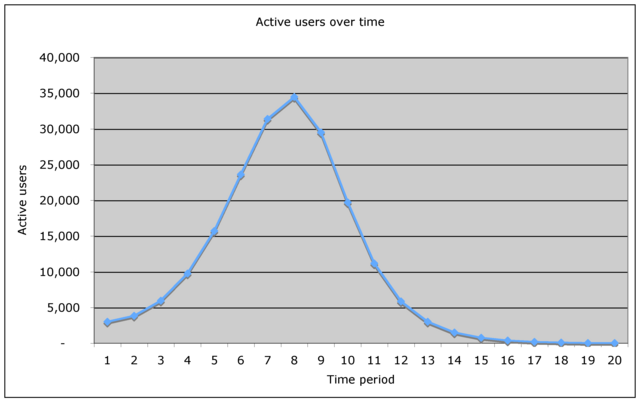This blog is a simple introduction to explain the K factor in viral growth for startup founders.
You’ve heard of going viral. It’s this magical thing where you put something out into the world and without much effort, you are an overnight sensation. But underlying this ‘magic’ is an actual math formula (that’s simple and wrong, ha!). This blog will focus on explaining the basics of it through something called the K factor.
Here are the other blogs on virality in this series:
Viral cycle time matters if you want to go viral
How to model viral growth at your startup
What is the K Factor?
It’s a basic formula to explain the growth of a service, app or piece of content. Described another way, it’s the number of new customers that each customer you beg, borrow or buy is able to successfully bring into your startup (for free!).
If you have you a really high NPS (They say they recommend you, right?) then you should have word of mouth.

Having a high NPS and getting customers through word of mouth is a sort of virality. Happy users are telling their friends about you and you hope that those friends will then sign up and pay you cash. If your word of mouth makes you exponentially larger, then you are going viral as your K factor is higher than one because each new user brings in more than one person and it goes on.
I actually differentiate virality (which is engineered) from word of mouth though for organic user, but let’s not get too complicated here. I want to keep this simple so you get how to drive more organic users.
K consists of two parts:
- Invitations: How many people are invited to use a service
- Conversion: Of those people who are invited, how many people become an organic user installed and become active users?
Simple right? It’s not hard to comprehend that this viral stuff actually comes from epidemiology (spread of diseases).
So let’s think about a zombie land app developers game.
You’re a zombie, and you have one way to win the game which is… how do you infect everyone really fast by biting? Well, you need to bite people and they need to catch the virus as you tear off their flesh, right? Then the people that become zombies start getting the munchies too.

But your virus might be kind of lame since you didn’t pay the app developers in this freemium game any $ to buy an exciting premium feature as an upgrade. So each person you bit may not get infected, they might just die.
So your invitation rate is how many people you bite and the conversion is how many get infected (and don’t die before they add more users).
Pretty simple, right? To level up, you need time to bite more and have higher efficacy. You prob wish you were able to share via social networks, right? Oh, wait, in the real world, you can!

What is the K-factor formula?
In math terms, the K factor formula is:
K= I x R
Where:
- I = invitations (Distribution- you buy more people to run around the game to grab)
- R = conversion rate (Infection- your bite has better venom points)
Invitations
I explained invitations as how many people a zombie can bite, but in startup terms it is how many additional users brough onto your site (or a portion since you will want to work with decimal places given math and all).
For an app startup your invitations are how many people a user drives by sending an invite along the lines of “Hey Jim, check out this app, you should check it out”. Some startups really spam the hell out you if they are able, but these days it’s not as easy to do (as things were for Zynga when they capitalised on Facebook having almost no rules).
Conversion rate
Jim sent customer invites and the zombie bit people so the virus spreads. So what you actually care about is how app invites convert into users or paying customers to get a higher k factor.
Who cares if Jim spams everyone he has ever met if those people ignore him?
You care about both the number of invites and the converting users. To achieve virality both of those numbers need multiply to just over one.
What is the value of the K-factor?
You internalised that the more people you bite and the more that get infected, the quicker you win the zombie game and everyone gonna die soon, right?
But we just looked at a formula. You multiply the two ‘variables’ and out comes a ‘coefficient’ which is K. Your variables are basically inputs and the coefficient is the output, to understand the mathy stuff all simple like.
So when you times a number and a %, is that number big or small, intuitively? It’s probably small, right?
So if I = 5 and your R = 10%, which seem like reasonable numbers, what is the coefficient? x times 10% is 0.5.
So if you increase I to 7 and keep R static, your K factor is not 0.7. Biting 7 humans is a fairly high number, right? So if you want that K to be higher we need to increase the R more, right?
If your I is 7 and we increase your r to 20% then now you have a K of 1.4.
So what?
So what is going viral?
So we have a K of 1.4. That’s viral and will hopefully drive active users.
0.7 is not viral.
0.99999999 is not viral.
1.0 is… not viral but it’s really nice.
1.0000001 is viral.
The second you are even slightly over 1.0 your K is considered viral.
Why?
Because in the zombie game when you bite people, humans turn and become zombies and start biting others, right?
Well, if you bite and have a K less than one, then you don’t have Warren Buffet’s fav friend, compounding growth. Virality is based on compounding and how many new users you keep adding.

Put it this way, if each person you bite then bites two more and they bite two more and so on you are suddenly going to turn New York into a disaster zone the Avengers can’t save. The numbers keep doubling and doubling uncontrollably.
If your K factor is less than one then the Punisher alone has time to cap your and your lame-ass hoard’s bum before it so much as reaches the news.
Now I wrote and everyone writes you aren’t viral if you are less than one. That’s wrong. We also write the definition of viral is a K greater than one, which is right. To be accurate you aren’t viral if your K is less than a number slightly greater than one (it’s just easier to write less than one ;)).
Having a K equal to one means you are in ‘steady state.’ You are neither growing nor declining.
A tiny fraction above and everything is different. You have exponential growth. Below one and you are in exponential decline.
Is virality that simple?
Well, that’s the explanation of K factor. Congrats! You’ve got it!
But… that’s just a tiny fraction of the bigger picture. ‘The truth is out there’ but it’s a lot more complicated as things such as churn rate have massive implications.
Firstly the K factor is a terrible formula. It doesn’t account for reality which is of course ‘fun’.
To understand it you need to understand a few things including the Adjusted Conversion Rate (So R is actually going to need to be AR) since we need to consider your market size (So, how many people can actually get bit and decreasing that number once more people get bit).
Next, virality is all about iterations (compounding) right? The video game doesn’t end after you bite one person. The zombie apocalypse happens from lots of biting – everyone biting everyone. How would you bring around the end of the world faster? More biting, right? And biting people and the time from bite to dead, to waking as a zombie and biting some poor fecker? In nerd language, that’s called the Cycle Time or (CT). Shorter CT means more zombies, faster.
So K is just a small part of ushering in the end of the world and I haven’t even laid on you the Effective Viral Growth Factor (EVGF) and Viral Invitation Factor (VIF).
Why do startups care about the k factor?
Acquiring customers is expensive. One of the simplest ways of thinking about a viable business is a CAC/LTV ratio. Put another way is that you acquire customers for a lot less than you make from them.
Some businesses just won’t make much money from their customers. Some apps might expect an LTV of a few dollars. Some SaaS companies focused on enterprise customers could have an LTV in the millions! But the cost to typically get each type of customer will vary due to 1/ economics, and 2/ the obvious fact you can’t logically pay $500 to get a customer that pays you $2 in total!
If you want to run a business that makes a lot of money by making small amounts from a lot of people then you need to buy those users for a little, not a lot. You want to pay for a few and drive a hell of a lot of organic users from them.
If you are able to have a high viral coefficient then you effectively only buy a few users and get a lot of extra ones for free. When you do a weighted average calculations on the cost to acquire customers then your startup becomes a lot more viable.
Do startups go viral and for how long?
This leads to the point that very few startups ever go viral, and even when they do, they do not do so for long.
Jason Lemkin wrote that Echosign had an average k factor of 0.2. He was delighted with that because it made the average cost of acquisition 20% less.
Going viral is a truly crazy thing and it can’t last long because you will churn through the market. Branchout was one such app that went viral and they failed as the product wasn’t great and they churned through their target market.
This is called jumping the shark when you burn through the market so the only way is down. Here you can see from Andrew Chen that this fictional company blew up then blew out after month 7.

What is a good K-factor?
You might think that a good k factor is anything above 1 and you would be correct if you want to be truly viral. But as I explained in the prior section, any k factor above 0 is in fact amazing as it reduced your aggregate acquisition costs.
You’re probably a founder interested in virality if you are reading this so what a good k factor is something you just want me to tell you so you have some kind of benchmark to set as a goal.
Well, it’s super hard to know as founders don’t share this information and I can tell you that I tried reaching out to some to get details.
I’m rewriting this blog in 2023 (written in 2019) so, fortunately, a dude called Michael Taylor did some work in the mean time you can see the details of here. “In order to answer the question, I’ve trawled through hundreds of blog posts to find instances where people actually shared their K-Factor publicly, so I could gather them all in one place.”
He compiled the following which is better than nothing as he mentioned “However these benchmarks are drawn from passing mentions in blog posts with no rigorous academic standards — we can’t know how they measured this metric, so don’t take these numbers too seriously.”
The k factor varies from 0.01 up to 8.5.
I will take pains to emphasise that Slack’s 8.5 was surely short-lived!
How do you kick off virality?
I received an email from a fan of my viral model on “where did the paid users come from in your model for campaign spend?”, so I need to explain how virality starts. The short version is existing users and new users.
You can ‘do things that don’t scale’ up to a point, but realistically you’re going to have to pay to get users to your site for any meaningful scale to kick things off. Now, whether paid is money to Google in SEM to target the right audience or ‘paid’ in the sense it is earned (even writing blogs costs money), you’re still paying to get users.
Understand that you need to assume you’re going to have to spend money to get organic users installed, to start getting in app store charts, so your viral loop starts kicking off. This means that you need a marketing plan to execute on and then to progressively engineer virality within your product.
In fact if you are starting to go viral, you should really splash the VC cash and feed the monster so you keep adding to existing users so your app’s virality k factor is capitalised on and you get data to keep iterating on.
How to improve the K factor?
This blog explains the basics of virality through introducing the k factor. How you actually engineer virality and improve all the constituent elements is a lot more complicated in practice.
To help you actually visualise and understand the consistent elements, I made a viral growth calculator to play with.
How to improve the k factor isn’t something I am covering in this blog. I cover it in How to model viral growth at your startup and in my model which you can download and play with.
Conclusion on K factor
In other blogs, we will get into each of these in more detail. For now, be happy. You’re one step into understanding this viral stuff with a handle on k factor.
Head here to learn more about viral growth math.



Comments 2
Very helpful and well written article. Definitely appreciated and am the better for reading it..
A
Author
Aloysius – Thanks. You are welcome